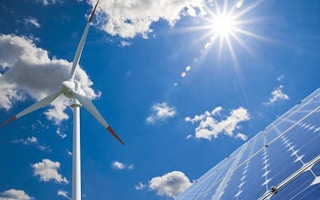Australia could phase out almost all its fossil-fuel sourced electricity by 2040 if it doubled the current rate of take-up of solar energy and wind energy maintained its current growth pace, said Professor Ken Baldwin, director of ANU’s Energy Change Institute.
While advances should be made “on all fronts”, including nuclear power, to shift the energy sector away from carbon-intensive coal and gas sources to avoid dangerous climate change, renewable energy could provide all but a couple of per cent of Australia’s electricity in under three decades, he said, citing data from ANU’s Centre for Sustainable Energy Systems.
Solar energy, currently dominated by photovoltaic cells, is adding about 1 gigawatt of capacity annually, roughly equivalent to the amount added by wind farms. If the pace of solar energy expansion doubled, starting in 2025, it would overtake fossil-fuel fired powerplants by 2030 and leave only a couple of gigawatts of coal or gas power by 2040 – down from almost 40 gigawatts now.
Professor Baldwin was speaking in the lead-up to a two-day conference starting on Thursday in Sydney to examine whether nuclear energy is the answer to Australia’s energy needs. His comments came as about 2500 delegates and exhibitors gathered in Brisbane for the Clean Energy Week, the industry’s biggest annual meeting.
While it remains possible for Australia to operate nuclear energy plants, the country would struggle to provide domestic expertise within 10 to 15 years for construction and maintenance of reactors. The need to import talent would raise security and quality questions, Professor Baldwin said.
Ian Lowe, Emeritus Professor of Science, Technology and Society at Griffith University, said the community concerns about nuclear energy remain strong, namely that it was too expensive, risky for its safety and proliferation issues, and would make too little difference to a low-carbon energy transition.
“For 40 years, we’ve been assured that there are better reactors on the drawing board that will solve the problems and they’ve failed to materialise,” Professor Lowe said. “If it is possible to meet our needs with renewables, why would we use nuclear power?”
Estimations
The solar prediction is based on several key assumptions, such the current decline in energy consumption levels out and stabilises at 2012 levels, said Professor Andrew Blakers, Director of ANU’s Centre for Sustainable Energy Systems.
Also, the model assumes no new gas or coal-fired power plant being added and that capacitgy factors of 35 per cent for wind and 20 per cent for solar are achieved.
Professor Blakers noted that some regions are already well down the path of dislodging fossil fuel sources, with SA already generating 29 per cent of its electricity from wind and Tasmania almost all of its power from hydro.
The ACT also plans to get to 90 per cent renewables by 2020, and the national renewable energy target is on course to deliver about 28 per cent of electricity from renewable sources by 2020, he said.
Public debate
Thursday’s conference at Sydney’s Powerhouse, Nuclear Energy for Australia?, will examine the potential for nuclear energy being added to the country’s energy mix.
“We need to bring this information to a public that is currently riveted by worst-case scenarios,” said Professor Alan Finkel, President of the Australian Academy of Technological Sciences and Engineering.
Professor Finkel said the tsunami and earthquake disaster at Japan’s Fukushima nuclear power plant had not produced any deaths from radiation and that the overall safety performance of the world’s reactors had been good over the past half century.
He cited research by former NASA climate scientist James Hansen that claims nuclear energy has helped to avoid 1.8 million deaths over the past 40 years as a result of less coal use. The deaths would have been caused by air pollution and accidents from mining and coal transport.
Putting a price on carbon would also improve the feasibility of nuclear energy, he said.
“A robust carbon price, if implemented, would help the economics of nuclear as much as it would help the economics of solar,” Professor Finkel said.










